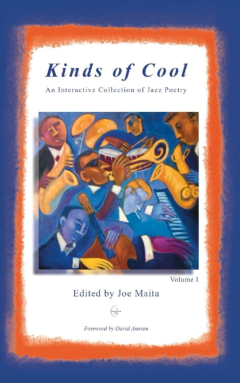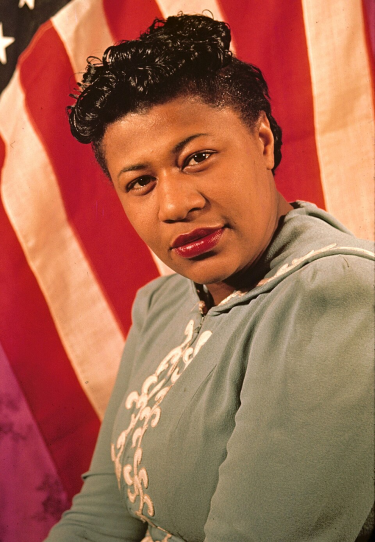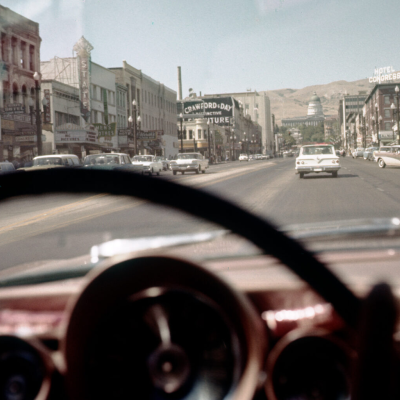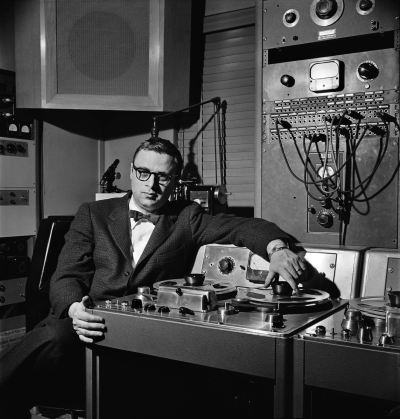The Sunday Poem: “Vamping” by Michel Krug
1. Morning light pours into my mind
driving out the blur of last night’s
torrential rain that sketched today’s agenda.
June 8th, 2025
1. Morning light pours into my mind
driving out the blur of last night’s
torrential rain that sketched today’s agenda.
June 8th, 2025
…or merely take Giant Steps?
I scramble! I step lightly / jump rope! / I crip walk
all the way to San Juan Capistrano because I heard
you playing sax in a dive bar in that city
February 26th, 2025
Eric Dolphy was one of jazz music’s first true multi-instrumentalists, and a pioneer of avant-garde technique. His life cut short in 1964 at the age of 36, his brilliant career touched fellow musical artists, critics, and fans of jazz music through his innovative work as a composer and bandleader. Jonathon Grasse’s Jazz Revolutionary effectively inspires readers to experience a deep and personal exploration of this unique artist’s historic recorded works, reminding us of the complexity of his biography along the way. He discusses his book – the first full biography of Eric Dolphy – in a December, 2024 interview.
...December 28th, 2024
.The Jazz Dive is the website of the musician and artist Allen Mezquida, whose work is described as “an independent art studio at the intersection of jazz and mid-century modern design” that is inspired by the counterculture music from the 1950s and 60s, and creates art “that resonates with both eyes and ears.” It is unique and creative and worth a look…
...December 18th, 2024
The evening burns,
riffs clinking glasses
dance to what is
not there.
My finger travels along the old
family photograph, 33 stern faces.
Forest cats in clan den, spotted,
camouflaged. Before I was born.
Who are they? No one knows.
December 12th, 2024
For over 60 years, the legendary recording engineer Rudy Van Gelder devoted himself to the language of sound. And although he recorded everything from glee clubs to classical music, he was best known for recording jazz – specifically the musicians associated with Blue Note and Prestige records. Joel Lewis writes about his impact on the sound of jazz, and what has become of his Englewood Cliffs, New Jersey studio.
...November 4th, 2024
John Coltrane was the absolute
the decorated, the preternatural
and acknowledged master of what fury
can pour out of the body of a saxophone.
September 3rd, 2024
The esteemed writer tells a story about the jazz world before, during, and after the 1959 recording of Kind of Blue, and how the album’s three genius musicians came together, played together, and grew together (and often apart) throughout the experience.
...August 26th, 2024
The story – a finalist in the recently concluded 65th Short Fiction Contest – concerns a heart-broken man trying to deal with his sadness via journaling and jazz.
...July 17th, 2024
Audible pain
Introspective
Like the composition he wrote called
Alabama about the 4 little girls from
Birmingham:
July 2nd, 2024
Soultrane came out when Ike governed.
1958. Before our nation
Would build up its war machine to invade
Viet Nam, training its Green Berets
March 23rd, 2024
Coltrane said a prayer to his musical God
Straight through the horn of his saxophone.
Not a metaphor; he spoke the words
Through the reed and the music into the air.
September 3rd, 2023
free
what
bars?
intra-
views,
posit-
ions
o-
pen.
August 6th, 2023
The light aspires to be equatorial
but each eroded moment quiets otherwise.
The twilight Superior shore fills
with pine smoke from fire pits
just as Coltrane played in the
smoldering light at the Village Vanguard.
July 23rd, 2023
The poets Richard Radcliffe and Svi A. Sesling share their experience of listening to and interacting with to the music of John Coltrane
...May 18th, 2023
An impeccably researched biography of an influential figure in American music, the goal of which is “to draw attention away from the circumstances surrounding Ayler’s death and bring it sharply back to the legacy he left behind.”
...April 5th, 2023
The poet is inspired by John Coltrane’s 1961 recording, “Ole”
...February 26th, 2023
The author considers John Coltrane’s intensity and tenderness, and how these two qualities intertwine in his improvisations.
...January 6th, 2023
“Fire From Heaven” arises from the poet Douglas Cole listening to John Coltrane’s 1964 album A Love Supreme
...October 24th, 2022
A review of Stephon Alexander’s book, “The Jazz of Physics: The Secret Link Between Music and the Structure of the Universe”
...September 20th, 2022
Cool, cool, ineffably cool,
his trumpet grieves with
a restraint barely able to be
embraced by listeners, his music
is pain on ice, whiskey frozen
September 13th, 2022
When in spring/Miles’s horn awakens/The nodding giant of the streets…
...June 2nd, 2022
. . Richard Brent Turner is Professor in the Department of Religious Studies and the African American Studies Program at the University of Iowa, and the author of Soundtrack to a Movement: African American Islam, Jazz, and Black Internationalism [New York University Press] . . ___ . . …..In Richard Brent Turner’s … Continue reading “Interview with Richard Brent Turner, author of Soundtrack to a Movement: African American Islam, Jazz, and Black Internationalism“
...April 1st, 2022
The author’s experience with racism, ignorance, poverty, and jazz in the American South of the 1960s.
...March 2nd, 2022
Gene Hyde’s poem connects nature and the moon to the music of John Coltrane
...March 1st, 2022
In this edition, producer Bob Thiele talks with Michael Jarrett, author of Pressed For All Time: Producing the Great Jazz Albums from Louis Armstrong and Billie Holiday to Miles Davis and Diana Krall about working with John Coltrane on his classic 1964 recording A Love Supreme
...February 19th, 2022
do you hear the wind?
see that scarlet leaf
dance on concrete?
I am that wind
I am that leaf
I am that dance
February 17th, 2022
I sit on a balcony,
a cup of coffee held for warmth
on a chill spring morning,
as waxwings and vireos flit and flash,
percolating with song.
November 26th, 2021
This saxophonist – best known for his Blue Note soul-jams of the 1960s – replaced John Coltrane in Earl Bostic’s early R&B/jazz band, played in Max Roach’s band after his time in the military, and was married to the organist Shirley Scott. Who is he?
.
Jimmy Scott
Benny Golson
Tom Scott
Eddie “Lockjaw” Davis
Eddie Harris
James Moody
Lou Donaldson
Stanley Turrentine
...July 28th, 2021
Spring rains watercolor the earth leaf, daffodil, violet,
then soften to a blue-gray mist,
and clear. Day’s begun transitioning, sky-bright blue to
lapis lazuli. Moon dreams in the north.
June 14th, 2021
. . photo by William Gottlieb/Library of Congress Sidney Bechet at Jimmy Ryan’s, New York, N.Y., ca. 1947 . …..I don’t know about you, but ever since Kenny G made himself known in the world of pop music, the soprano saxophone has been a challenge for me to enjoy. His “smooth” approach to the … Continue reading “Playlist: A sampling of soprano saxophonists”
...May 19th, 2021
“What’s he even mean by that,” my son asked the other day.
Whose love? What love? And for whom?
May 16th, 2021
An interview with The Art of Jazz author Alyn Shipton, whose book is an exploration of how jazz influenced sheet music art, album art, posters, photography, and individual works of fine art.
...April 25th, 2021
A poem by Michael Amitin celebrating John Coltrane’s classic “A Love Supreme” recording
...March 29th, 2021
He drove uptown on Riverside Drive, the motor noise magnificent. Traffic increased as he approached Harlem. Other drivers jostling to get ahead noticed the car first. A red Ferrari was not subtle in gray Manhattan, and the engine roared money and power and European elegance. Then neighbors would study the man in outsized sunglasses. Some recognized him, smiling or shaking their heads in disbelief. Others looked aggrieved, even outraged that a person like him could be driving a vehicle like that. Ferrari only built three-hundred of their 275 GTB.
...March 12th, 2021
Hunkered down
listening to Coltrane’s
Once in a While
and the smooth flow
of his sax, a whiskey
beside me, thinking
of those Jazz-infused
moments before life
began to drift away.
February 23rd, 2021
Author Dave Chisholm talks about the experience creating his graphic novel about Charlie Parker in California, “Chasin’ the Bird”
...February 15th, 2021
Wading through the gloaming, almost majestic,
looking ready for a coronation, the bird stretches
wings as though sweeping night air from his regal
January 27th, 2021
Mosaic Records is offering prints of entire contact sheets of classic Blue Note recording sessions that, as described by Mosaic owner Michael Cuscuna, shows Francis Wolff’s “thought process and the progression of shots that lead to his final best image.”
...May 21st, 2020
With yesterday’s passing of pianist McCoy Tyner, the world lost a major creative voice of the past 60 years. So much joy and awe in virtually every groove he carved…
...March 7th, 2020
Walking on the wall around Jerusalem’s Old City
I meet Gary, a potter from New Orleans.
He tells me he’s hitchhiking to Africa
but talks mostly about music—
February 21st, 2020
warped certified gold hangs over the shoulder,
…………………………………blue on the wall,
……………..notes on Trane (Coltrane).
September 7th, 2019
Mosaic Records co-founder Michael Cuscuna shares news concerning the availability of previously unreleased photographs of Blue Note Records sessions taken by Francis Wolff
...August 8th, 2019
Mac’s Restaurant and Nightclub in Eugene, Oregon is where the blues aficionados in Central Oregon congregate to enjoy Cajun type bar food and dance joyously to pounding, power guitar driven blues. Our friends Alan and Susan go there a couple times a month to satisfy their boogie dance cravings. Whenever my wife and I pass through Eugene, we end up at Mac’s with Alan and Susan. They also attend a lot of blues festivals around their neck of the woods and can be considered connoisseurs.
I too love the blues. I also love jazz. Susan loves the blues. She does not love jazz, “modern” jazz to be specific. Susan explains that when she’s dancing at Mac’s, she feels the pounding bass and drums and screaming vocalist and Fender Stratocaster vibrating her bones and muscles and eyeballs. That’s her heaven. That’s how she wants to
...September 3rd, 2018
there’s new Coltrane out
lost recordings tootin’ the devil’s horn
and while I’ve been leery
of these “new” releases, how
wrong can John Go?
even John on scat is pure
...August 29th, 2018
In a 2016 Business Insider post, the physicist Stephon Alexander – author of The Jazz of Physics: The Secret Link Between Music and the Structure of the Universe – writes about the connections between John Coltrane, described by Alexander as a “musical innovator, with physics at his fingertips,” and Albert Einstein, who “was an innovator in physics, with music at his fingertips.”
Coltrane’s music, particularly his final three records, helped Alexander realize that improvisation is a characteristic of both music and physics. “Much like Einstein working with his thought experiments, some jazz improvisers construct
...July 2nd, 2018
When the needle touches
the wax that will sing
the collected prayers
of A Love Supreme, it’s
like the
June 11th, 2018
April 15th, 2018
In a March 29 post on Slate, Fred Kaplan writes about the newly released bootleg recording of Miles Davis’ quintet (featuring John Coltrane), The Final Tour, a four-CD box set of live concerts in Europe from 1960. The tour happened a year after the release of Kind of Blue, so many of the tunes played during it is from that classic album. According the Kaplan, the music found on this Columbia/Legacy set is “radically different” and such a “jarring departure” from the album that “it demands we revise the conventional wisdom about these two musicians (Miles and Coltrane) and fills in some blanks…in the story of jazz, and where it was going, in those pivotal years.”
Kaplan’s essay includes a critique of the music itself – but of particular interest is his reminder of the
...April 1st, 2018
I.
All those good times
might’ve been what Duke
had in mind when vamping
his silky-fingered B-flats,
letting Coltrane counter
until tenor notes cluster
close to the
...January 9th, 2018
In Robbie Robertson’s entertaining biography Testimony, the rock guitarist tells a short story about a conversation he overheard Bob Dylan having with The Byrd’s Jim (a.k.a. “Roger”) McGuinn concerning John Coltrane’s influence on McGuinn when he wrote “Eight Miles High.”
The setting was Los Angeles, 1966, during a Dylan tour that employed Robertson and, among others, bandmates Rick Danko and Richard Manuel, who are referred to in the excerpt. The “Levon” in the story was the drummer Levon Helm, who left the tour after a month out of frustration of playing with Dylan during his initial “electric” period, when folk music purists routinely
...January 7th, 2018
The purpose of motion begins,
A clear mind, aware and in focus,
Ahead, the optical pathway lies empty and silent,
Slow at the start, breathing steady,
Stepping through the changes,
Favouring a motif,
Blowing hard,
As the intensity builds,
June 18th, 2017
Yes, it is hot,
night sweats beneath
Spanish moss and the terror in trees
now knowing no cover of darkness
to greet a Sunday morning
10:22 a.m.
under the stairs
16th Street Baptist Church.
“Three minutes”
and the siren wails
February 19th, 2017
For years, the autobiography proved elusive,
speeding east like the double-jointed run
that skipped from white keys to black,
soldiers chased from Central Avenue battles.
Then the book took a rest, hiding out
in a nondescript store among academic texts,
tomes whose covers bore geometric shapes.
Cardboard screamed orange, red, and white,
the slow burn of a
September 13th, 2016
I watch my hand remove the phone from the wall above the couch’s arm and there is a sweat in my ear as I hear a distant Miles Davis. I am called by the distorted voice of Miles Davis rasping my name.
John, he says, are you busy?
I let my eyes blur into my mother’s sofa, melting a monotonous no out of my mouth toward the receiver. I feel the room sloshing peacefully in waves around me and the buzzing of my lips from my mouthpiece and reed. My saxophone sits strewn across the floor along with my
...September 3rd, 2016
In a brilliant piece titled “Universal Consciousness: The Spiritual Awakening of Alice Coltrane,” Britt Robson writes that “the closer one examines the genuinely phenomenal life, music and spirit of Alice Coltrane, the more inevitable it seems that she will also someday receive her proper due. The most striking aspect of her biography is that she became a master musician and a spiritual guru in the same way, by carrying forth all her accumulated wisdom in a welcoming synthesis, rather than shedding, judging and discriminating her way to ‘growth’ and ‘maturity.'”
This extensive biography focuses on Alice’s musical path, her marriage to John Coltrane, her ensuing spiritual awakening, and her influence on
...May 23rd, 2016
In 1960, Eric Dolphy told Down Beat magazine, “At home I used to play, and the birds always used to whistle with me. I would stop what I was working on and play with the birds.” This imitation of birds (who, according to Dolphy, sing in “quarter tones”) was embraced by none other than John Coltrane, who said that the addition of Dolphy — and his philosophy — to his quartet “turned [the quartet] all around.” Dolphy’s playing helped set the stage for the music Coltrane would create later.
Also critical was their friendship, which was especially important to Coltrane since he was so consumed at the time by his alcohol and heroin abuse. Quoting a Coltrane friend, John Fraim writes in his 1996 biography Spirit Catcher: The Life and Art of John Coltrane that “outside of Sonny Rollins, Eric Dolphy was his [Coltrane’s] only true
...December 12th, 2014
Tunes come to me at morning
prayer, after flax sunflower
seeds jammed in a coffee can;
when we went to Japan
I prayed at the shrine
for the war dead broken
at Nagasaki;
the tears on the lip of my soprano
glistened in the sun.
In interviews
I talked about my music’s
voice of praise to our oneness,
them getting caught up in techniques
of the electronic school
lifting us into assault;
in live sessions, without an audience
I see faces on the flues of the piano,
cymbals driving me into ecstasies on my knees,
the demonic angel, Elvin,
answering my prayers on African drum,
December 11th, 2014
Ask just about any jazz musician, scholar or fan for a list of the greatest jazz albums ever recorded, and John Coltrane’s A Love Supreme — recorded 50 years ago today — resides on it. My own first experience with it was in 1975, on a late evening in a dark, smoke-filled, back alley cottage on North Oakland’s Alcatraz Avenue. My listening was guided by a dear friend who understood that this was not just music — it is what happens when musical genius meets intensity, sensitivity, and spirituality. So many details of that evening remain with me 40 years later, not the least of which was how I sunk into the couch, eyes closed, the worn Impulse album jacket never leaving my grip. I was amazed and I was hooked.
Over the years, I have found that a favorite discussion among jazz fans is their recollections of their first experience with this album. When I began developing content for Jerry Jazz Musician, one of the first ideas I had was to interview people who were either
...December 9th, 2014
The Five Spot Café, a club located in New York City’s Bowery neighborhood, was the site of a six month gig for the quartet of Thelonious Monk, John Coltrane, drummer Shadow Wilson, and bassist Wilbur Ware. This engagement — coming on the heels of Monk’s cabaret card reinstatement — marked the merging of two of the most original voices in American music, Monk and Coltrane, in a space where cheap beer and good music attracted some of the city’s most influential artists and writers. Regulars included Larry Rivers, Willem de Kooning, Franz Kline, Jack Kerouac, Frank O’Hara and Allen Ginsberg.
In Thelonious Monk: The Life and Times of an American Original, author Robin D.G. Kelley quotes Five Spot co-owner Joe Termini remembering the impact Monk’s quartet had on his club: “Once we hired Monk, all of a sudden the place was crowded every night. And frankly, in the beginning, I just didn’t understand any of it.”
...October 30th, 2014
Coltrane
by Alan Patterson
His Voice
crying in the wilderness
sighing, screeching, singing,
of soul secrets and sufferings
stark, silent sound
invoking Heaven’s muse
and Purgatory’s cleansing fire.
Who, speaking in toungues
created new language
who captured Eternity’s essence
June 5th, 2014
Coltrane, Dig?
I suppose what it is with trane and me is
he takes all the time he wants to take
even outside of time, sidereal time,
stardust time, bessie blue time,
through-and-through-him time,
trancey groove time, even arranged time.
October 19th, 2013
Terry on Bass, 1974
Tall
slim straight
long red hair
that cops and rednecks hated
he’d stride to his deep honey bass
feel its pleasure in his big hands
urge out music that turned souls to listen
his freedom plucking up down strings
April 2nd, 2010
9 23 99: Coltrane Notes on the Millenium
by Michael Harper
“Alabama”
no protection still
that is not churchdriven
James Weldon Johnson’s alternate tune
January 22nd, 2007
Stanley Crouch — MacArthur “genius” award recipient, co-founder of Jazz at Lincoln Center, National Book Award nominee, and perennial bull in the china shop of black intelligentsia — has been writing about jazz and jazz artists for over thirty years. His reputation for controversy is exceeded only by a universal respect for his intellect and passion. As Gary Giddins notes: “Stanley may be the only jazz writer out there with the kind of rhinoceros hide necessary to provoke and outrage and then withstand the fulminations that come back.”
...September 10th, 2006
Following the path of its star musician John Coltrane, Impulse Records cut a creative swath through the 1960s and 1970s with the politically charged avant-garde jazz that defined the labels musical and spiritual identity. Ashley Kahn’s The House That Trane Built tells the story of the label, balancing tales of individual passion, artistic vision, and commercial motivation.
...July 29th, 2006
Excerpted from A Love Supreme: The Story of John Coltrane’s Signature Album, by Ashley Kahn
Miles Davis was desperate. He was in the midst of preparing for his first national tour arranged by a high-powered booking agent, and Columbia Records — the most prestigious and financially generous record company around — was looking over his shoulder, checking on him. “If you can get and keep a group together, I will record that group,” George Avakian, Columbia’s top jazz man, had promised. To Miles, an alumnus of Charlie Parker’s groundbreaking bebop quintet, “group” still meant a rhythm trio plus two horn players, but he still had only one: himself.
...February 22nd, 2004
More than half a century after his bebop debut, and more than eleven years after his death, Miles Davis lives on. His music is used to pitch jeans, shape films, and personify an era. To this day, he is revered as the archetype of cool.
While several books have been written about Davis, including his own autobiography, due to his passion for reinvention and his extreme reticence the real story of Miles Davis has been obscured by the legend and widely misunderstood.
...January 27th, 2003
A successful recording generally entertains and communicates passion on an earthly, mortal level. We typically respond to an effective performance by humming the melody, tapping our feet, and sharing it with friends. It might even “stomp the blues,” as the critic Albert Murray suggests.
Few recordings, however, actually challenge a listener to address one’s personal essence.
...September 16th, 2002
Lee Tanner began using a camera as a teenager in New York City. An avid jazz fan from the age of eight and inspired by the jazz photography of Gjon Mili, Bill Claxton, Herb Snitzer, and Herman Leonard, he turned to documenting the jazz scene with a love for the music comparable only to his creative drive for visual expression. Photography, however, was only an avocation.
...July 29th, 2002
Village Voice writer Gary Giddins, winner of the National Book Critics Circle Award, and who is the country’s eminent jazz critic, joins us in a June 21, 2002 conversation about jazz great John Coltrane.
...June 21st, 2002
Brown University professor Michael Harper, the first Poet Laureate of the State of Rhode Island, and author of the National Book Award nominated collection, Dear John, Dear Coltrane, discusses John Coltrane and reads his poems.
...January 24th, 2002
Joshua Redman entered the jazz world with tons of expectation and perhaps an unreasonable amount of hope. Pat Metheny went so far as to suggest Redman is “the most important new musician in twenty years.”
While Methenys point can be argued, Redman has created some of the most consistently compelling jazz during the last ten years. His music borrows from a storied past and experiments with an elegant future.”
While Methenys point can be argued, Redman has created some of the most consistently compelling jazz during the last ten years. His music borrows from a storied past and experiments with an elegant future.
...December 12th, 2001
Philadelphian Francis Davis is the author of several books, including The History of the Blues, Bebop and Nothingness and a forthcoming biography of John Coltrane. A contributing editor of The Atlantic Monthly, he also writes regularly about music for the New York Times, among others.
...December 10th, 2001
Nat Hentoff was born in Boston in 1925 and lived there until he moved to New York City at the age of twenty-eight. For many years he has written a weekly column for the Village Voice. His column for the Washington Times is syndicated nationally, and he writes regularly about music for the Wall Street Journal. His numerous books cover subjects ranging from jazz to civil rights and civil liberties to First Amendment issues.
...November 20th, 2001
Few musicians have had the impact on the world of music that McCoy Tyner has. His sound has influenced pianists in each of his six decades as a performer. Noted jazz critic Scott Yanow says, “Along with Bill Evans, Tyner has been the most influential pianist in jazz of the past 40 years with his chord voicings being adopted and utilized by virtually every younger pianist.”
While his career continues to move ahead, he will forever be best known as the pianist in John Coltrane’s famed Quartet of the early 1960’s, a group long since recognized as the ultimate jazz combo, whose eclectic, spirited work constantly demanded listeners to reach well beyond their safest star. A Love Supreme, recorded in 1964, is a landmark in music, and to this day the centerpiece to the Quartet’s vast, unparalled universe.
...November 8th, 2001
Author John Fraim is a very interesting man. Taking on a subject like John Coltrane is not a left-brain experience. He knew wisdom and historical perspective were required before writing about a complex, musical prophet, and wrote this biography the way Coltrane lived his life In his award-winning book, Spirit Catcher, The Life and Art of John Coltrane, he presents Coltrane’s life as spiritual quest, and in it creates a piece of art not often found in biographical form.
...October 29th, 1999

Click here to read about plans for the future of Jerry Jazz Musician.




”Hours of Jazz” by David Dephy
The Sunday Poem is published weekly, and strives to include the poet reading their work.... David Dephy reads his poem at its conclusion
Click here to read previous editions of The Sunday Poem




























Dear Readers:
Reader funding helps support the expense of publishing this website, and to keep it free of advertising – which is a rarity in the dot-com world. Many thanks to those who have recently contributed, and to those who have done so multiple times. Your support is very much appreciated.
If you are able, please consider making a contribution? Information regarding how to do so is found by clicking here.
For viewing my long range vision for Jerry Jazz Musician, please click here.
To view the content on Jerry Jazz Musician, simply click on the “close” tab.
Thank you!
Joe Maita
Editor/Publisher
,

